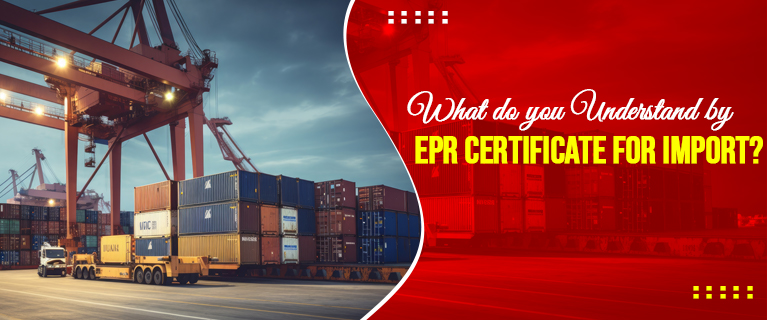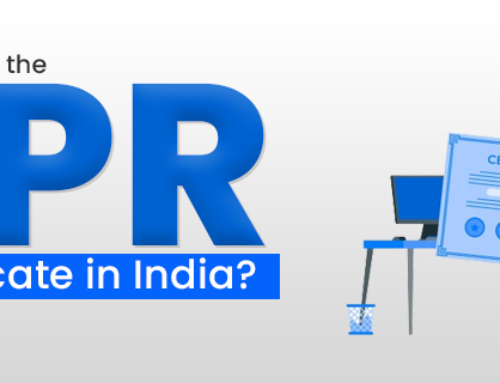In the complex world of international trade, various certifications and documents play a pivotal role in ensuring smooth and sustainable transactions. One such essential document is the EPR (Extended Producer Responsibility) Certificate for Import. EPR certification holds increasing significance as countries worldwide strive to create a more environmentally conscious and responsible trading environment.
The Basics of EPR:
Contents
- The Basics of EPR:
- Environmental Concerns and Global Trade:
- Key Components of EPR Certificate for Import:
- 1. Product Life Cycle Analysis:
- 2. Packaging Compliance:
- 3. Waste Management Plans:
- 4. Financial Assurance:
- EPR Certificate in Action:
- Challenges and Opportunities:
- The Future of EPR in International Trade:
- Conclusion:
Extended Producer Responsibility is a concept that places the responsibility for the environmental impact of a product throughout its life cycle on the producer. In the context of international trade, an EPR Certificate for Import ensures that the imported products adhere to specific environmental standards and regulations set by the importing country.
Environmental Concerns and Global Trade:
The growing awareness of environmental issues has led to an increased focus on sustainable practices in various industries. Governments are enacting stringent regulations to address the environmental impact of products and packaging, and the EPR Certificate serves as a tool to enforce these regulations in the realm of international trade.
Read also this -: EPR Registration Online – Register Your Business with Ease
Key Components of EPR Certificate for Import:
1. Product Life Cycle Analysis:
EPR Certificate necessitates a comprehensive analysis of the product’s life cycle, from raw material extraction to manufacturing, distribution, use, and disposal. This ensures that every stage is environmentally responsible.
2. Packaging Compliance:
Packaging is a significant environmental concern. The EPR Certificate verifies that the imported products comply with packaging standards, encouraging sustainable and recyclable materials.
3. Waste Management Plans:
Importers must provide detailed waste management plans, outlining how the product and its packaging will be managed after use. This includes recycling, disposal, or any other environmentally sound methods.
4. Financial Assurance:
Some countries require importers to provide financial assurance as a security deposit, ensuring that in case of any environmental damage, the funds are available for cleanup and restoration.
EPR Certificate in Action:
1. Reducing Environmental Footprint:
The EPR Certificate encourages importers to adopt eco-friendly practices, leading to the reduction of the environmental footprint associated with imported goods.
2. Promoting Sustainable Manufacturing:
Manufacturers, in response to EPR requirements, are compelled to adopt sustainable production methods, thereby contributing to global efforts to combat climate change.
3. International Cooperation:
EPR Certificates foster international cooperation in environmental protection by setting a common standard that importers worldwide must adhere to, promoting a shared commitment to sustainable trade.
Challenges and Opportunities:
1. Compliance Costs:
Meeting EPR Registration standards might incur additional costs for importers, leading to concerns about competitiveness. However, it also presents an opportunity for businesses to invest in sustainable practices, aligning with changing consumer preferences.
2. Uniform Standards:
Achieving a globally accepted standard for EPR Certificate can be challenging due to variations in environmental regulations and practices among countries. However, efforts are underway to create a harmonized approach.
3. Consumer Education:
Challenge: Lack of awareness among consumers about EPR Certificate and its significance can hinder the success of such programs.
Opportunity: Businesses can engage in extensive consumer education campaigns, fostering a greater understanding of environmental responsibilities and creating a demand for eco-friendly products.
4. Technology Integration:
Challenge: Implementing effective EPR Registrations may require significant technological investments, posing a hurdle for some companies.
Opportunity: Investing in innovative technologies can streamline waste tracking, recycling processes, and overall environmental impact assessment, offering long-term efficiency gains.
5. Supply Chain Complexity:
Challenge: Managing EPR Certification across complex global supply chains can be intricate and resource-intensive.
Opportunity: Enhanced supply chain transparency and collaboration can lead to improved waste management strategies, allowing businesses to identify and address environmental impacts more effectively.
6. Governmental Support:
Challenge: The absence of consistent governmental support and policies for EPR Certificate can impede widespread adoption.
Opportunity: Advocacy for clear and supportive EPR Registration can provide a conducive environment for businesses to embrace sustainable practices without fear of competitive disadvantage.
7. Circular Economy Integration:
Challenge: Shifting from a linear to a circular economy model requires systemic changes in production and consumption patterns.
Opportunity: Embracing circular economy principles can lead to resource efficiency, reduced waste, and new business models, offering long-term economic and environmental benefits.
8. Small Business Adaptation:
Challenge: Small and medium-sized enterprises may find it challenging to comply with EPR due to limited resources.
Opportunity: Government incentives and collaborative initiatives can assist small businesses in adopting sustainable practices, fostering a more inclusive and comprehensive EPR Registration.
Each of these challenges and opportunities underscores the complexity and potential benefits associated with Extended Producer Responsibility, emphasizing the need for a balanced and collaborative approach among businesses, governments, and consumers.
Read also this -: Guide To Getting EPR Certification Online
The Future of EPR in International Trade:
As environmental concerns continue to escalate, the significance of the EPR Certificate for Import is likely to grow. Governments and international bodies are exploring ways to strengthen and streamline EPR regulations to create a more robust and effective framework for sustainable trade.
Countries and international bodies are actively working towards establishing a unified set of EPR Certification standards, reducing discrepancies and promoting consistency in environmental regulations across borders.
A standardized EPR Certificate for Import could facilitate smoother international trade by providing a common ground for compliance, reducing confusion for businesses operating in multiple jurisdictions.
Future trade agreements may include provisions that encourage or mandate adherence to EPR Certificate, signalling a shift towards a more environmentally conscious global trade landscape.
Incentivizing sustainable practices through trade agreements can foster a collective commitment to responsible production and waste management.
Anticipated advancements in technology, such as blockchain and IoT, may be integrated into EPR frameworks to enhance traceability and transparency in the movement of goods.
Utilizing technology can help monitor and verify compliance, ensuring that imported products adhere to the prescribed environmental standards.
International organizations and platforms dedicated to environmental sustainability may play a pivotal role in shaping the future of EPR Certificate in international trade. Collaborative efforts can include the sharing of best practices, information exchange, and the development of common tools to assess and improve the environmental impact of traded goods.
Governments and international bodies might introduce incentives for businesses that invest in eco-friendly innovations and practices, encouraging the development of sustainable products and packaging. This approach could lead to a more competitive landscape where companies actively seek environmentally friendly solutions to gain a market edge.
The future may see the implementation of more robust enforcement mechanisms, including stricter penalties for non-compliance with EPR Certificates. Stronger enforcement can act as a deterrent, ensuring that businesses prioritize environmental responsibility in their international trade practices.
Collaborations between governments, private sector entities, and non-governmental organizations may become more prevalent in shaping and implementing EPR Certificate regulations for international trade.
Such partnerships can leverage the strengths of each sector to create comprehensive and effective strategies for sustainable trade.
Read also this -: How To Register EPR Online And Who Is Required To Do The Registration
As consumers become more environmentally conscious, there may be an increasing demand for products with transparent and verifiable environmental credentials.
EPR Certificate in international trade could evolve to not only meet regulatory standards but also align with consumer expectations, further incentivizing businesses to adopt sustainable practices.
The future of EPR Certificates in international trade is likely to be characterized by a combination of regulatory developments, technological advancements, collaborative efforts, and a growing emphasis on sustainability throughout the supply chain. This evolution reflects a broader global commitment to addressing environmental challenges through responsible trade practices.
Conclusion:
In conclusion, the EPR Certificate for Import is a crucial element in fostering environmentally responsible international trade. It ensures that products entering a country comply with specific environmental standards, promoting sustainable practices and reducing the overall ecological impact of global commerce. As the world moves towards a more sustainable future, the EPR Certificate stands as a beacon for responsible and eco-conscious trade practices.






